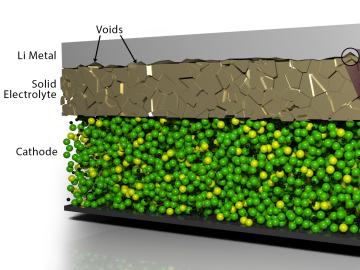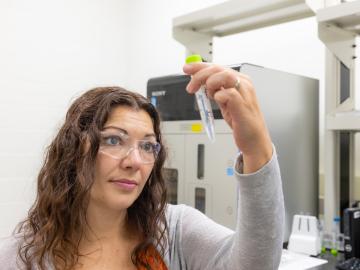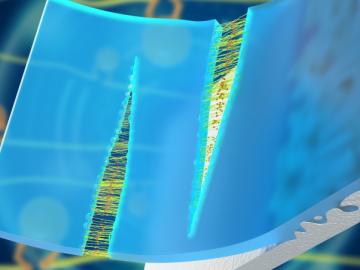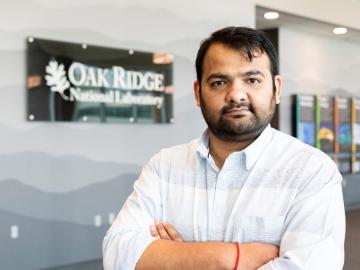
Filter News
Area of Research
- Biological Systems (1)
- Biology and Environment (59)
- Biology and Soft Matter (1)
- Computational Biology (1)
- Computational Engineering (1)
- Computer Science (1)
- Electricity and Smart Grid (1)
- Energy Science (87)
- Fusion and Fission (9)
- Fusion Energy (1)
- Isotopes (6)
- Materials (45)
- Materials for Computing (8)
- National Security (15)
- Neutron Science (23)
- Nuclear Science and Technology (8)
- Supercomputing (80)
News Type
News Topics
- (-) Advanced Reactors (24)
- (-) Biomedical (59)
- (-) Coronavirus (36)
- (-) Energy Storage (75)
- (-) Frontier (60)
- (-) Grid (48)
- (-) High-Performance Computing (113)
- (-) Polymers (22)
- (-) Software (1)
- 3-D Printing/Advanced Manufacturing (104)
- Artificial Intelligence (112)
- Big Data (53)
- Bioenergy (93)
- Biology (106)
- Biotechnology (35)
- Buildings (45)
- Chemical Sciences (70)
- Clean Water (18)
- Composites (23)
- Computer Science (174)
- Critical Materials (16)
- Cybersecurity (31)
- Education (5)
- Element Discovery (1)
- Emergency (3)
- Environment (154)
- Exascale Computing (64)
- Fossil Energy (7)
- Fusion (54)
- Hydropower (6)
- Isotopes (53)
- ITER (6)
- Machine Learning (50)
- Materials (111)
- Materials Science (111)
- Mathematics (8)
- Mercury (9)
- Microelectronics (4)
- Microscopy (40)
- Molten Salt (5)
- Nanotechnology (46)
- National Security (78)
- Neutron Science (136)
- Nuclear Energy (94)
- Partnerships (67)
- Physics (60)
- Quantum Computing (48)
- Quantum Science (79)
- Security (28)
- Simulation (52)
- Space Exploration (16)
- Statistics (3)
- Summit (62)
- Transportation (56)
Media Contacts

Ten scientists from the Department of Energy’s Oak Ridge National Laboratory are among the world’s most highly cited researchers, according to a bibliometric analysis conducted by the scientific publication analytics firm Clarivate.

The U.S. Department of Energy’s Office of Science announced allocations of supercomputer access to 51 high-impact computational science projects for 2022 through its Innovative and Novel Computational Impact on Theory and Experiment, or INCITE, program.

Researchers at ORNL designed a novel polymer to bind and strengthen silica sand for binder jet additive manufacturing, a 3D-printing method used by industries for prototyping and part production.

A team including researchers from the Department of Energy’s Oak Ridge National Laboratory has developed a digital tool to better monitor a condition known as Barrett’s esophagus, which affects more than 3 million people in the United States.

Scientists at the Department of Energy’s Oak Ridge National Laboratory have developed a scalable, low-cost method to improve the joining of materials in solid-state batteries, resolving one of the big challenges in the commercial development of safe, long-lived energy storage systems.

Carrie Eckert applies her skills as a synthetic biologist at ORNL to turn microorganisms into tiny factories that produce a variety of valuable fuels, chemicals and materials for the growing bioeconomy.

Research teams from the Department of Energy’s Oak Ridge National Laboratory and their technologies have received seven 2021 R&D 100 Awards, plus special recognition for a COVID-19-related project.

Marm Dixit, a Weinberg Distinguished Staff Fellow in the Emerging and Solid-State Batteries Group at ORNL, has been awarded a Toyota Young Investigator Fellowship for Projects in Green Energy Technology from the Electrochemical Society.

An international problem like climate change needs solutions that cross boundaries, both on maps and among disciplines. Oak Ridge National Laboratory computational scientist Deeksha Rastogi embodies that approach.

Pengfei Cao, a polymer chemist at ORNL, has been chosen to receive a 2021 Young Investigator Award from the Polymeric Materials: Science and Engineering Division of the American Chemical Society, or ACS PMSE.


